There are many landmarks in Colombia that attract visitors from all over the world, thanks to its rich heritage, blending pot of cultures, and interesting geographical location.
From the snow-capped peaks of the Andes Mountains to the steamy jungles of the Amazon, this country is full of natural and historical wonders. In addition, there are many ancient ruins and colonial towns that testify to Colombia’s rich history.
Without further ado, here are the 21 most famous Colombia landmarks! We’ll give you a map near the end of the article where you can save this list and use it to plan your Colombia itinerary!
What Are The Most Famous Colombia Landmarks?
1. Cocora Valley
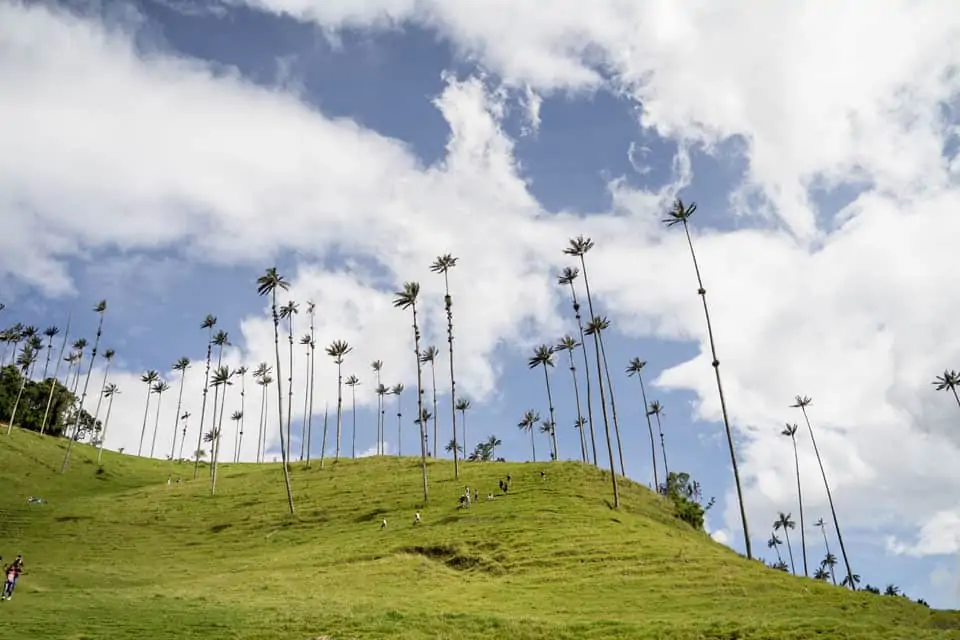
Cocora Valley is one of the most famous natural landmarks in Colombia. It’s a lush and verdant valley located in the heart of the country’s coffee region, near the town of Salento. The main attraction here is the towering wax palm trees, the world’s tallest palm trees, which can grow up to 60 meters (200 feet) tall!
Visitors can take a hike through the valley to admire the stunning scenery or go on a horseback ride to explore the area further. Note that the Cocora Valley hike is quite a strenuous one and it takes about 4 to 5 hours to complete.
However, hikers are rewarded with incredible panoramic views of the valley and its majestic palm trees. If you’re visiting Colombia, Cocora Valley is definitely one of the landmarks you shouldn’t miss!
2. Tayrona National Park
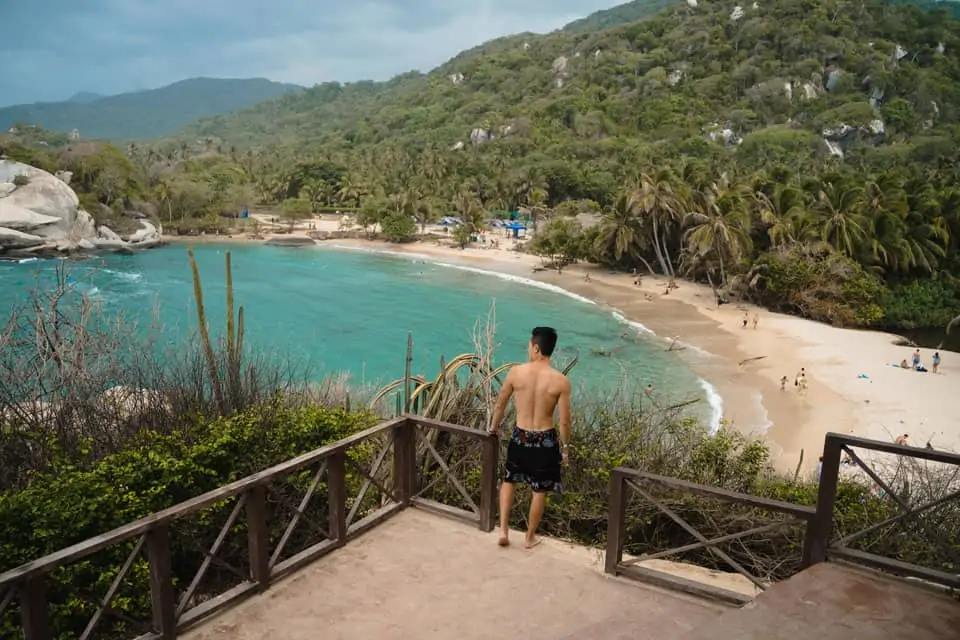
With its soaring palm trees swaying on the shores of the finest Caribbean beaches, Tayrona National Park is one of the most beautiful places in Colombia. Located on the country’s Caribbean Coast, it is a place where the Sierra Nevada rainforest meets the beach and where a huge number of plants and animal species call home.
The park has a number of hiking trails which lead to different campsites and beaches. The most popular beach is Cabo San Juan, which has turquoise waters and a sandy beach.
Its most iconic feature is a watchtower that juts in the sea, and visitors looking for a unique experience can rent one of the hammocks there overnight. Listening to the waves of the sea as you drift to sleep is something you won’t soon forget.
But Tayrona National Park is not only about beaches and relaxation. The park is also home to the indigenous tribes descended from the Tairona people, who have managed to preserve their traditional way of life. It is truly one of the most interesting places in Colombia.
3. Zipaquira Salt Cathedral
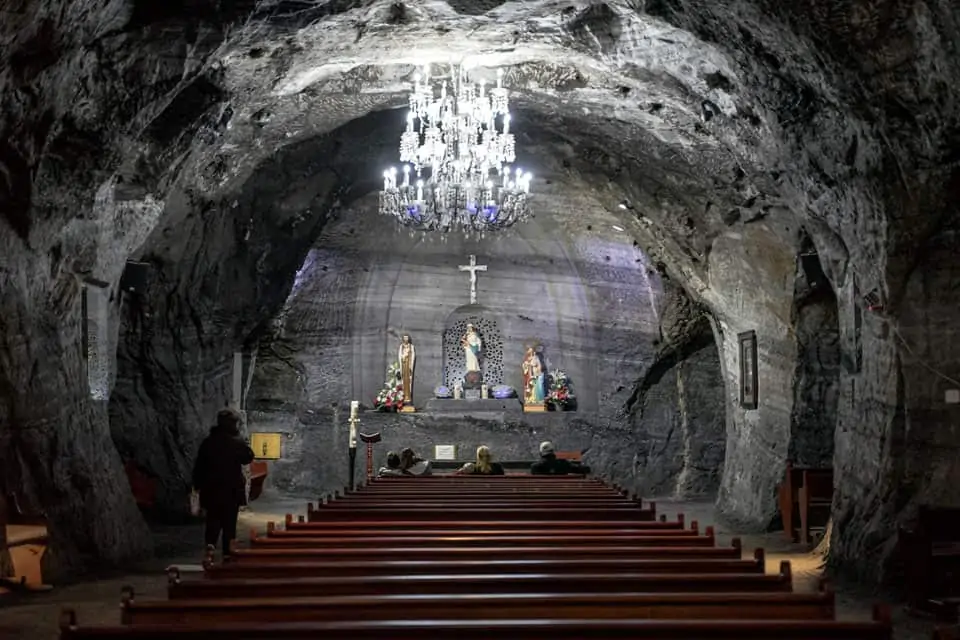
If you are talking about architecture, the Zipaquira Salt Cathedral has to be the most epic landmark in Colombia. It’s a Roman Catholic church that was built inside a salt mine near the city of Zipaquira, about an hour’s drive from Bogota. In 2007, it was designated as the First Wonder of Colombia.
The church is located 200 meters (660 feet) below ground level and it features three naves, each representing different parts of the Christian faith. The main nave is home to the largest underground cross in the world.
The walls and ceilings are adorned with beautiful salt sculptures and the overall effect is simply breathtaking. During religious holidays, the Zipaquira Salt Cathedral is filled with people attending mass. It is estimated that the place can hold around 10,000 people!
4. El Penon del Guatape (Guatape Rock)
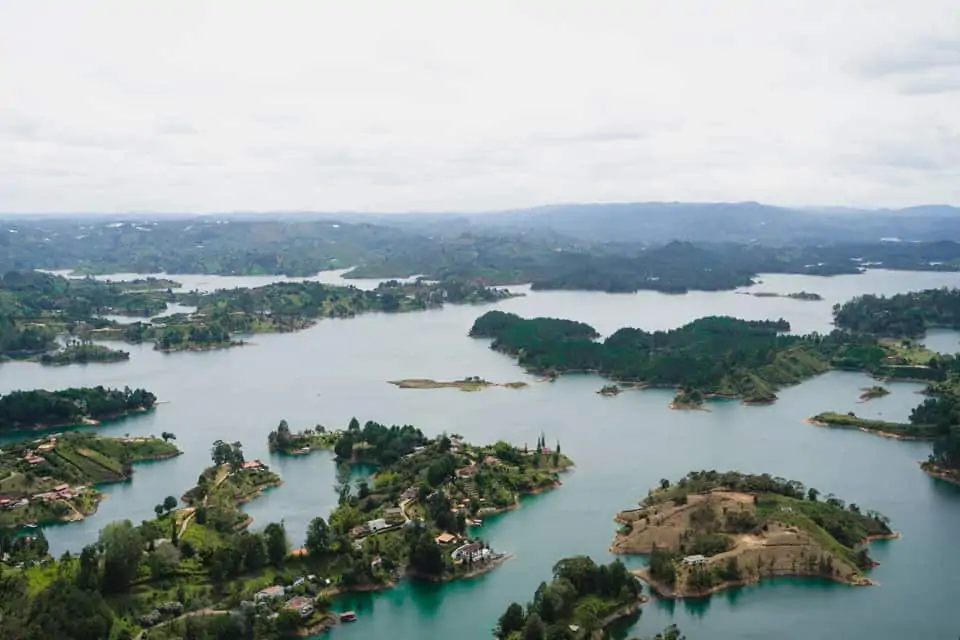
El Penon del Guatape, or Guatape Rock, is one of the most popular tourist attractions in Colombia. It’s a gigantic monolith located just on the outskirts of the town of Guatape, about two hours from Medellin. The rock is over 200 meters (650 feet) high and it offers stunning views of the surrounding area.
To get to the top of the rock, you have to climb a staircase of over 650 steps. But don’t worry, there are plenty of rest stops along the way so you can catch your breath. Once you reach the top, you’ll be rewarded with views of greenery and the crystal clear water of Guatape Reservoir.
Keep in mind that the staircase can be quite crowded, especially on weekends or any Colombian holidays, so it’s best to go early in the morning. You do not want to be stuck on that small staircase!
5. Comuna 13
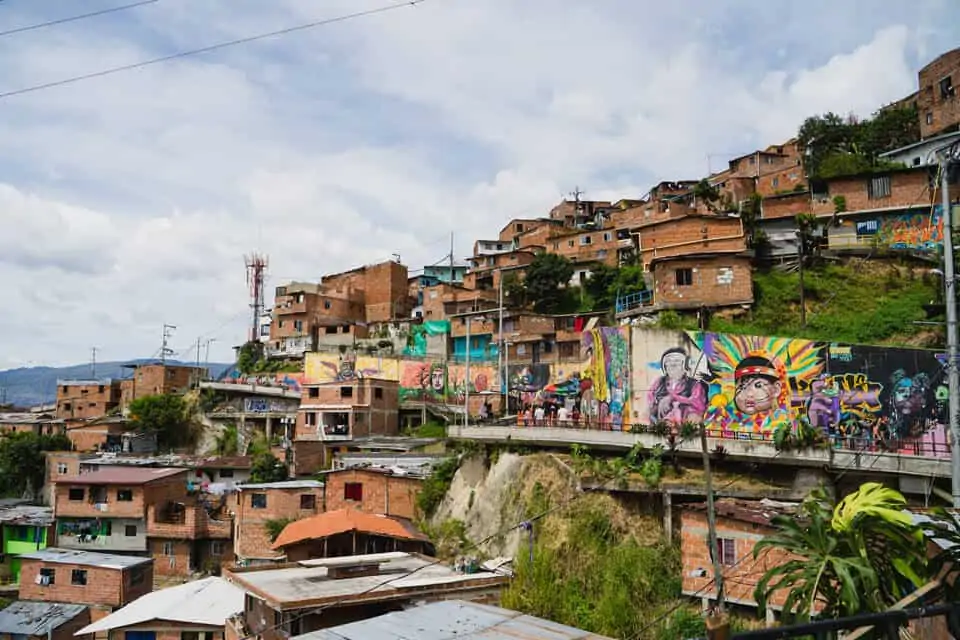
Comuna 13 used to be one of the most dangerous places in Medellin. In fact, in 1993, TIME said that Medellin is the most dangerous city in the world, and at the heart of all the violence and crime is Comuna 13.
But thanks to a community-led urban regeneration project, it is now one of the coolest places in the city.
The area is home to a number of street art murals, which were painted by local artists as part of the regeneration project. The murals depict the struggles of the community and they tell the stories of the darkest moments in Colombian history.
This famous neighborhood in Colombia is no longer what it was in the past, and is now home to tons of hip cafes and restaurants. When visiting, make sure you go with a local guide from the area so you can get a firsthand recount of the tales.
6. Tatacoa Desert
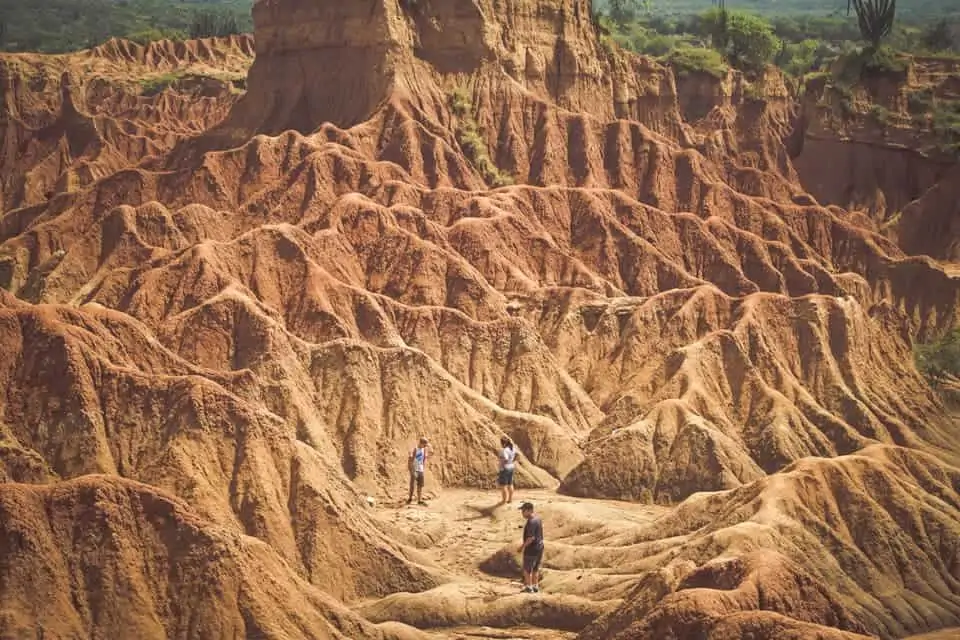
The Tatacoa Desert is one of the most unique landscapes in Colombia. It’s located in the department of Huila, about six hours from Bogota. The desert is made up of red and grey soil, and it looks otherworldly.
There are a number of different hiking trails in the Tatacoa Desert, and you can even go on horseback rides. The best time to visit is during the dry season (January to March), when the temperatures are more bearable.
At night, the Tatacoa Desert turns into one of the best places in Colombia for stargazing. The sky is so clear that you can see constellations with your naked eye. Who knows? You might even see a shooting star!
7. Caño Cristales
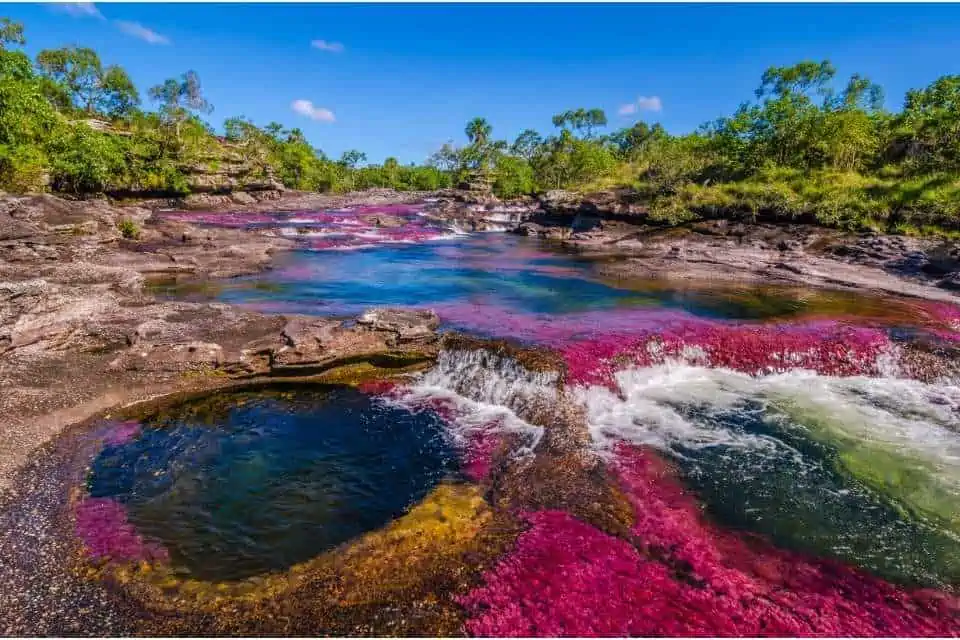
Caño Cristales is often called the “River of Five Colors” or the “Liquid Rainbow.” It’s located in the Serrania de la Macarena National Park, about four hours from Bogota.
The river gets its colors from macarenia clavigera, an endemic river plant that needs the ideal conditions to live and give off its colors. The best time to see the colors is between June and December, when the water flow is higher and the colors are more vibrant.
During this time, the river is a beautiful shade of yellow, green, blue, red, and orange. The Serrania de la Macarena National Park is also a beautiful national park full of exotic flora and fauna. In fact, many scientists consider it to be one of the richest wildlife reserves on Earth.
8. Lost City (Ciudad Perdida)
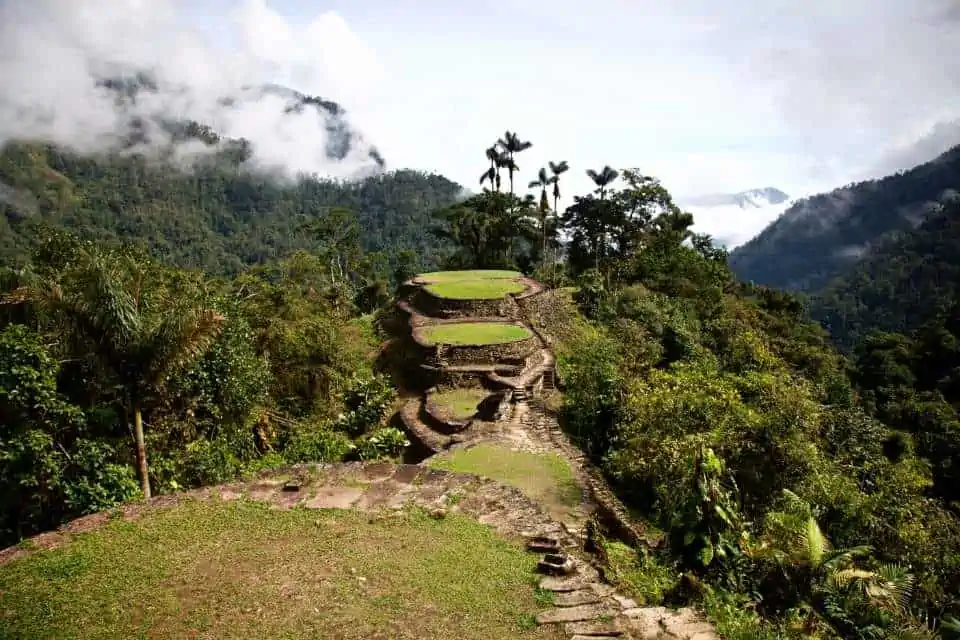
The Lost City, or Ciudad Perdida, is one of the most famous historical landmarks in Colombia. It’s an ancient city that was built by the Tairona people over a thousand years ago. The city is located in the Sierra Nevada de Santa Marta mountains near Colombia’s Caribbean coast.
To reach the Lost City, you have to go on a four-day trek through the jungle. Combined with the humidity and weather of this Caribbean region of Colombia, the trek is quite gruesome.
But along the way, you’ll pass by waterfalls, rivers, and stunning scenery. You’ll also get to meet the local indigenous people who live in the area. This iconic Colombia trek is both a cultural and a physical experience, and it can be compared to the Inca Trail and Machu Picchu in Peru!
9. Monserrate Mountain
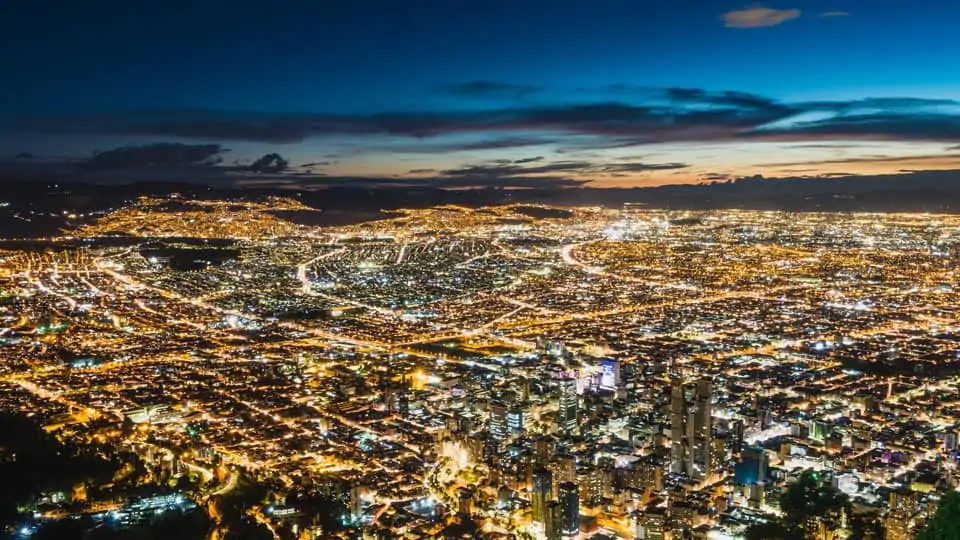
Monserrate Mountain is one of the most famous landmarks in Bogota. The mountain is home to a 17th-century church, which can be reached by either taking a cable car or hiking up the mountain.
Situated 133 meters above the city of Bogota, the views from Monserrate Mountain are absolutely stunning. On a clear day, you can see all of Bogota from the top. The best time to visit is at sunset. Though it’ll be crowded, visitors can see all of the lights in Bogota turn on at once and watch the city come to life.
If you’re up for a challenge, you can try to hike up one of the trails that lead to the top of Monserrate Mountain. But be warned, it’s a tough hike, especially with the high altitude that Bogota is known to have.
10. Castillo San Felipe de Barajas
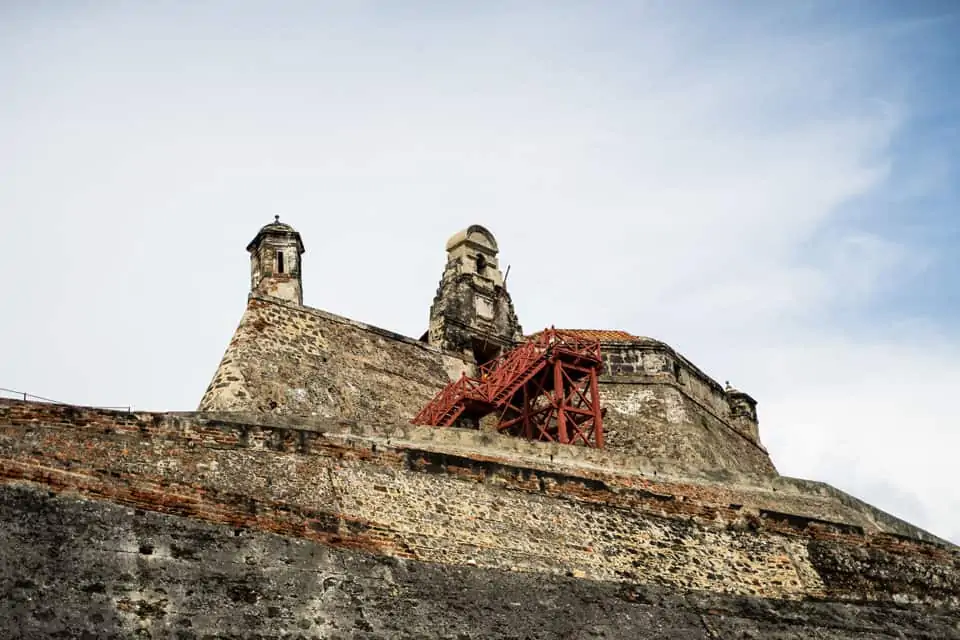
The fortress of Castillo San Felipe de Barajas is one of the most recognizable landmarks in Cartagena and is part of the UNESCO World Heritage site of Cartagena.
Cartagena was a vital trading port in colonial times. To protect against pirates and other invaders, the fortress was built by the Spanish in 1536. The castle is perched on a hill overlooking the city of Cartagena, and it has a stunning view of the Caribbean Sea.
Inside the fortress, there are a number of different tunnels and chambers that were used by soldiers to navigate the castle. Visitors can explore them and get a feel of life in the castle back then. You can also climb to the top of one of the towers for an even better view.
As one of the most impressive fortification systems of Cartagena, visiting Castillo San Felipe de Barajas is one of the best things to do in Colombia.
11. Walled City Of Cartagena
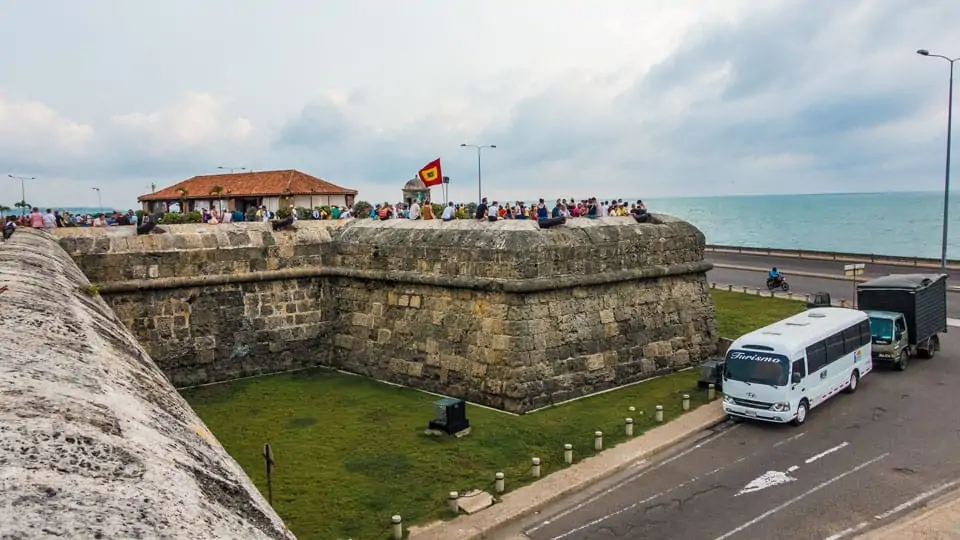
The Walled City of Cartagena is one of the most stunning places to visit in Colombia. The city is full of colonial Spanish architecture, has a beautiful Caribbean coastline, and is home to a number of different historical landmarks.
One of the most impressive things about the Walled City is its fortifications. The Spanish King Philips III ordered the walls to be built after a pirate attack from the infamous Sir Francis Drake in 1614. The walls are as tall as 12 meters high in some places and stretch for about 11 kilometers.
There are a number of different gates that lead into the Walled City, but the most famous one is Puerta del Reloj, or Clock Tower Gate. This gate is located in the center of the Walled City and is one of the most photographed landmarks in Colombia.
Inside the Walled City, visitors are likely to bump into Palenqueras, a group of women that were the first free black slaves in the Americas. If you’re interested in Colombian history, then make sure you add the Walled City of Cartagena to your itinerary.
12. Las Lajas Sanctuary
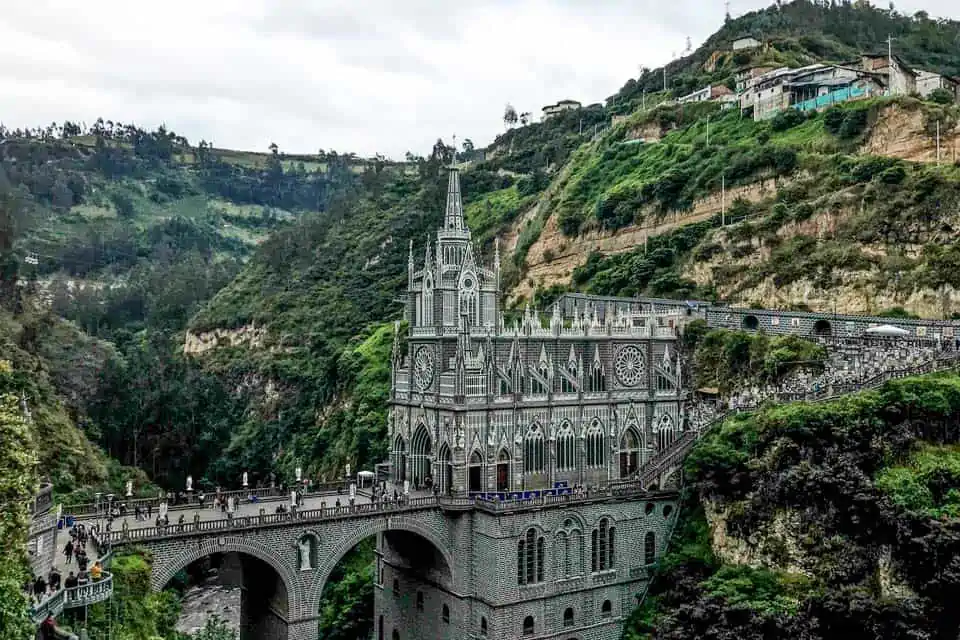
Las Lajas Sanctuary is a hidden gem and one of the most beautiful places in Colombia. It is located in Ipiales, a small town in the Andes Mountains in Southwestern Colombia, just on the border with Ecuador.
The sanctuary was built in 1754 and dedicated to the Virgin Mary. It is said that she appeared to a woman who was hiding in the Guáitara River Canyon with her child during a heavy storm.
The sanctuary is a popular pilgrimage site for Catholics and is considered one of the most beautiful churches in the world.
The church is built into the Guáitara River canyon and over a river. The bridge that connects one side of the canyon to the church is jaw-dropping and comparable to some of the most beautiful castles in Europe.
Along with an interior that is decorated with stained glass windows and marble columns, Las Lajas Sanctuary is certainly a must-visit place in Colombia.
13. The Coffee Triangle
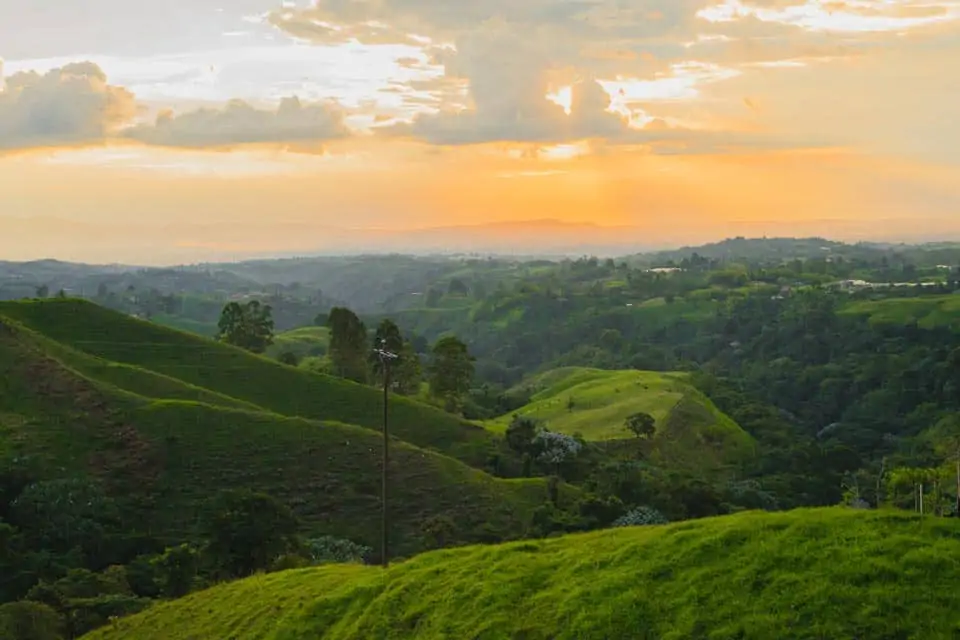
The Coffee Triangle is one of the most famous regions in Colombia. It is located in the central-western part of the country, between the cities of Armenia, Pereira, and Manizales.
Thanks to the temperature climate, rich soil, and plenty of precipitation, the region produces some of the best coffee in the world. Colombian coffee farmers have also perfected the art of growing and processing them, a skill that has been passed down from generation to generation.
Colombian coffee beans are also 100% Arabica, which is the superior type of coffee bean known for its richer and smoother flavor profile. But since most coffee beans are exported out of the country for more profit, you need to visit a coffee plantation to sample the country’s best coffee.
Here you can also learn about the process of making coffee from bean to cup, and of course, drink plenty of delicious Colombian coffee.
14. Cerro Azul Cave Paintings
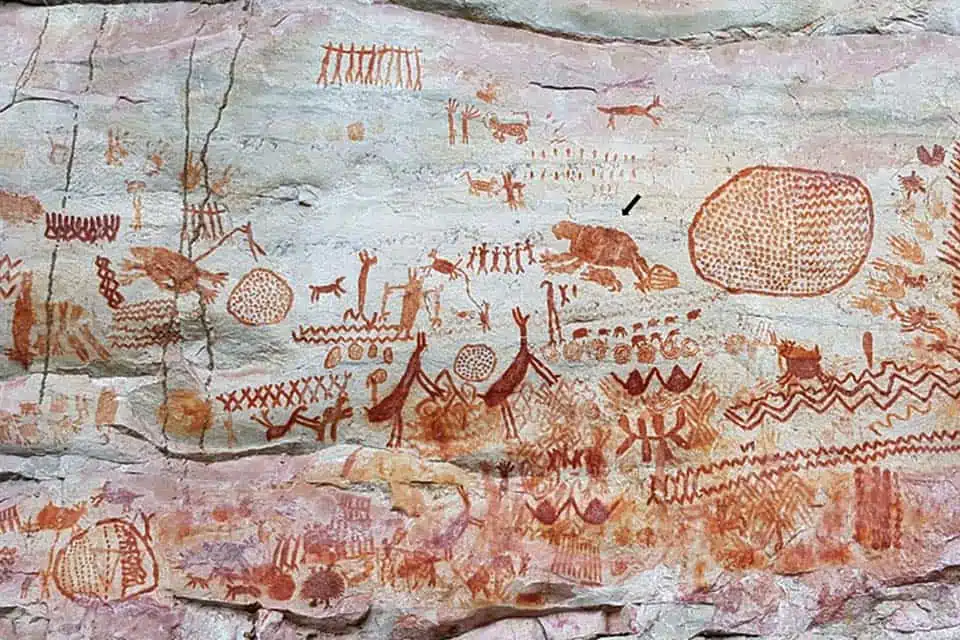
Cerro Azul is one of the most famous archaeological sites in Colombia. It is located in the Serranía de la Lindos Mountains of the Guaviare Department, a remote place that should only be visited by those prepared for a long and rough commute.
The site consists of a large rock shelter with over hundreds of paintings, which date back to over a thousand years ago in the pre-Columbian era. The paintings depict a variety of animals, including jaguars, snakes, llamas, humans, and give visitors a glimpse of the people that once lived here.
The Cerro Azul cave paintings are believed to be one of the oldest examples of rock art in South America and are an important part of Colombia’s cultural heritage.
15. San Agustin Archaeological Park
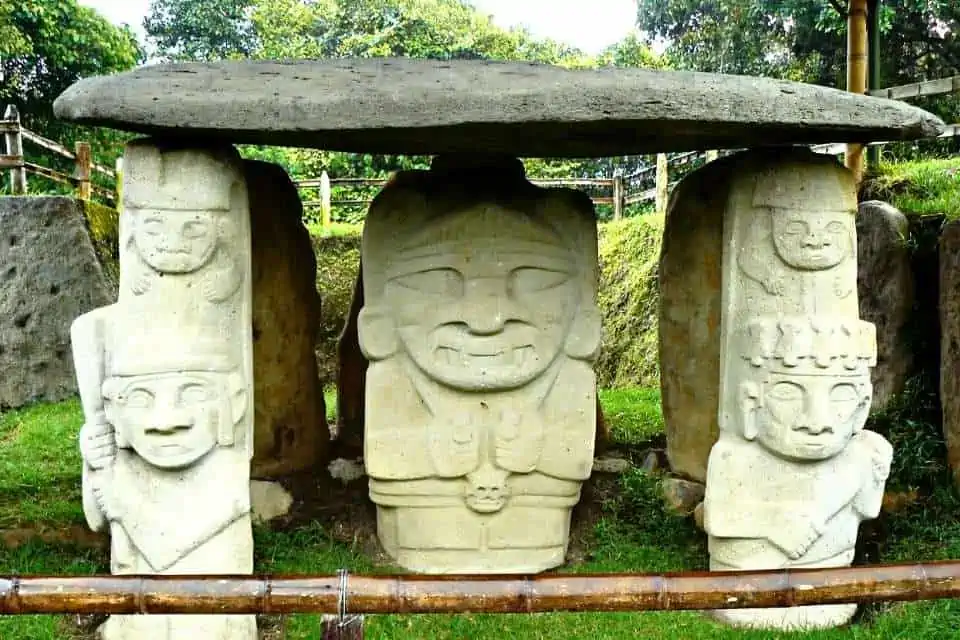
The UNESCO World Heritage Site of San Agustin Archaeological Park is home to the biggest religious monuments and megalithic sculptures in South America.
Located in San Agustin of Huila Department, the park consists of several archaeological sites containing ruins of the pre-Columbian San Augustin culture, one that dates back to the 4th BCE!
The main purpose of the site is for burial, and with 116 hectares in area, it is considered the world’s largest necropolis!
If you want to see some of the most famous monuments in Colombia and a cultural landmark in South America, make sure you head to San Agustin Archaeological Park!
16. The Islands of San Andres and Providencia
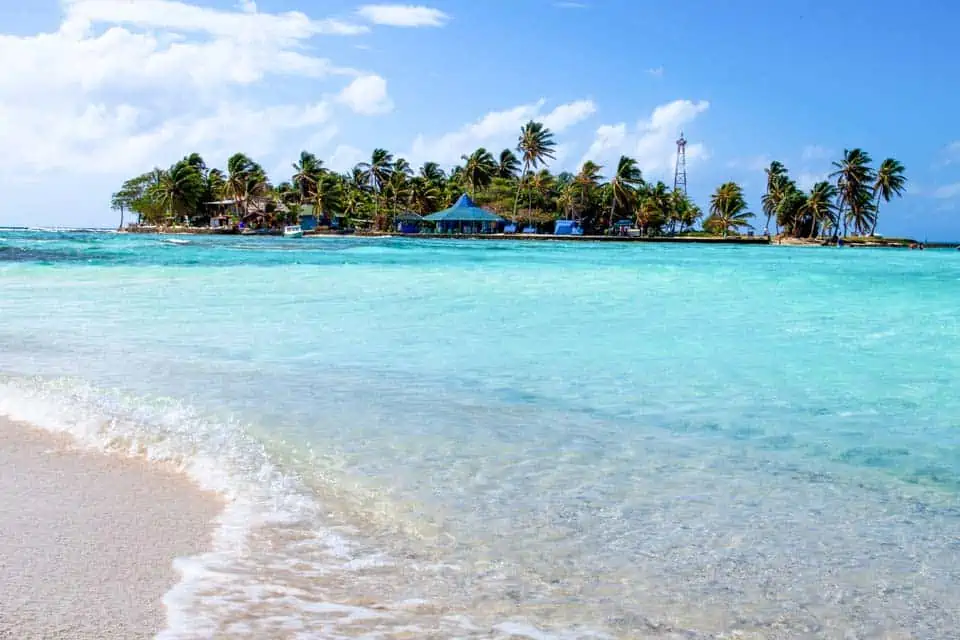
If you are looking for the best beaches in Colombia, then the Caribbean islands of San Andres and Providencia are where you need to go. Though part of Colombia, the islands are closer to Nicaragua.
San Andres is the larger of the two islands and is a popular tourist destination with its white sandy beaches and clear blue waters that are perfect for snorkeling. It is a still small island, so visitors can hire a Golf Buggy and go from attraction to attraction.
Providencia, on the other hand, is more low-key with a focus on eco-tourism. It’s perfect for those who want to get away from the hustle and bustle of city life and enjoy nature.
No matter which island you choose, you’re going to love the beautiful weather of these tropical islands and the glistening waters of the Caribbean Sea!
17. Chicamocha Canyon
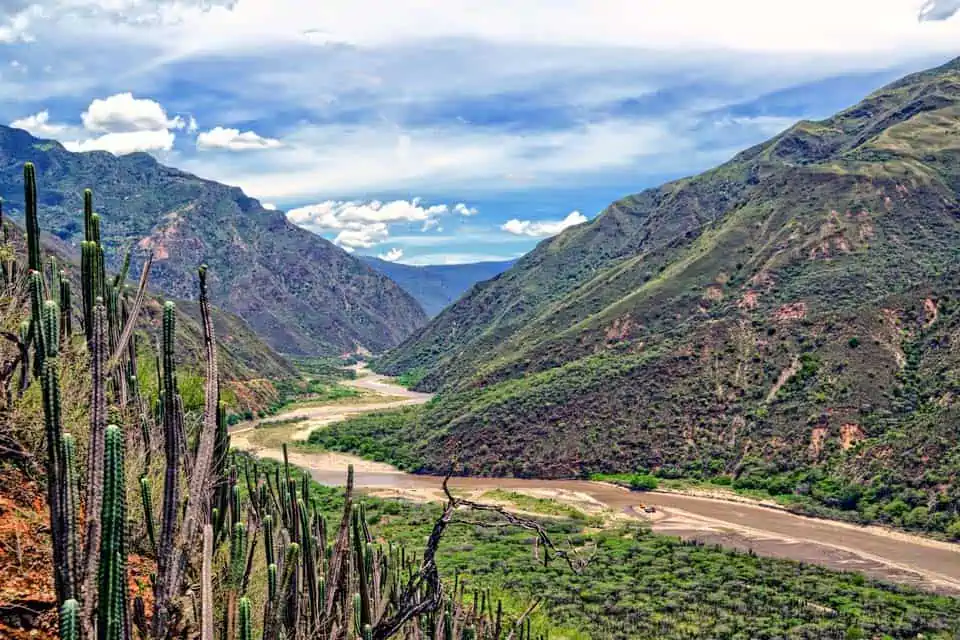
If you are looking for natural landmarks in Colombia, head to Chichamocha Canyon. Located in the Santander Department of Colombia, it is one of the best places to visit in the nearby town of San Gil.
The Canyon is known as the second largest canyon in the world, with an area of 108,000 hectares (270,000 acres), a maximum depth of 2,000 meters (6,600 ft), and a length of 227 kilometers (141 mi).
Formed by the erosion of the Chichamocha River, the canyon has become a popular location for adventure seekers as there are many activities such as hiking, mountain biking, zip-lining, and more!
18. Chiribiquete National Park
Without a doubt, the best national park in Colombia is Chiribiquete National Park, also known as the “Maloca of the Jaguar”. This UNESCO World Heritage Site is not only the largest national park in Colombia, but it’s the largest tropical rainforest national park in the entire world.
It is the connecting point of four biogeographical provinces: Amazon, Orinoc, Andes and Guyana.
The biodiversity in Chiribiquete National Park is beyond incredible. Besides incredible wildlife diversity, this National Park in the Colombian Amazon is home to numerous indigenous tribes, and archaeological ruins that tell the stories of their ancestor.
In fact, the name “Maloca of the Jaguar” comes from the numerous historical paintings of jaguars in the park.
One of the most unique geological features of Chiribiquete National Park is the tepuis, table-top mountains that look absolutely unworldly. They are some of the oldest geological formations on earth and are worth exploring.
19. La Chorrera Waterfall
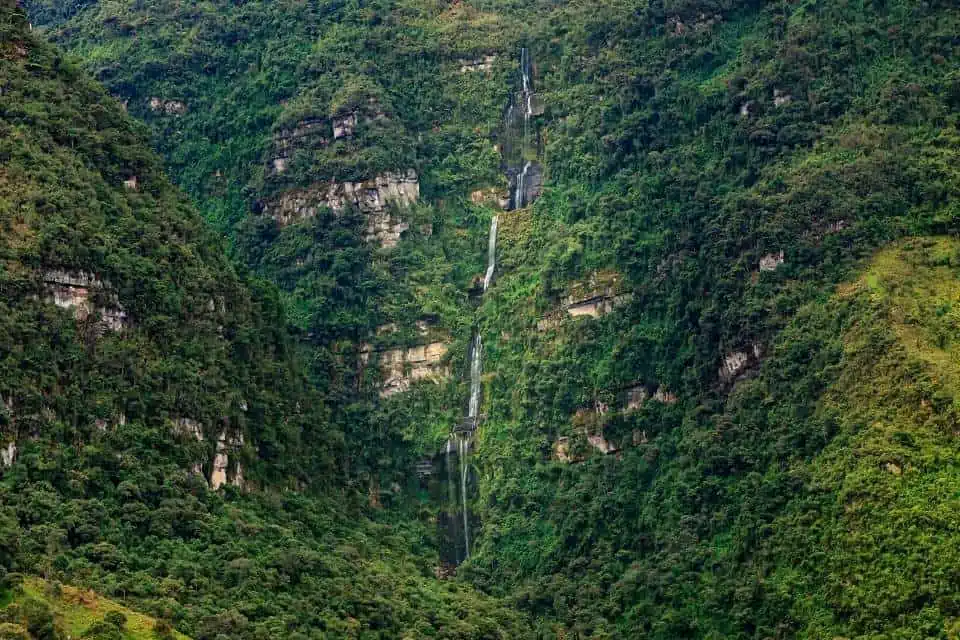
No list of Colombia’s most famous landmarks is complete without including Cascada La Chorrera, or La Chorrera Waterfall in English. Standing at 590 meters, La Chorrera Waterfall is the tallest waterfall in Colombia, and yet its fame is nearly non-existent.
The waterfall is situated only 13 kilometers east of Bogota near the town of Choachi. From there, visitors can take a Jeep taxi to the Aventura La Chorrera Park. The park is home to La Chorrera Waterfall, as well as El Chilfon Waterfall, which is a smaller but equally stunning fall.
The nature surrounding these waterfalls offers some of the best landscapes in Colombia.
20. The Retreating Glaciers of Los Nevados National Natural Park
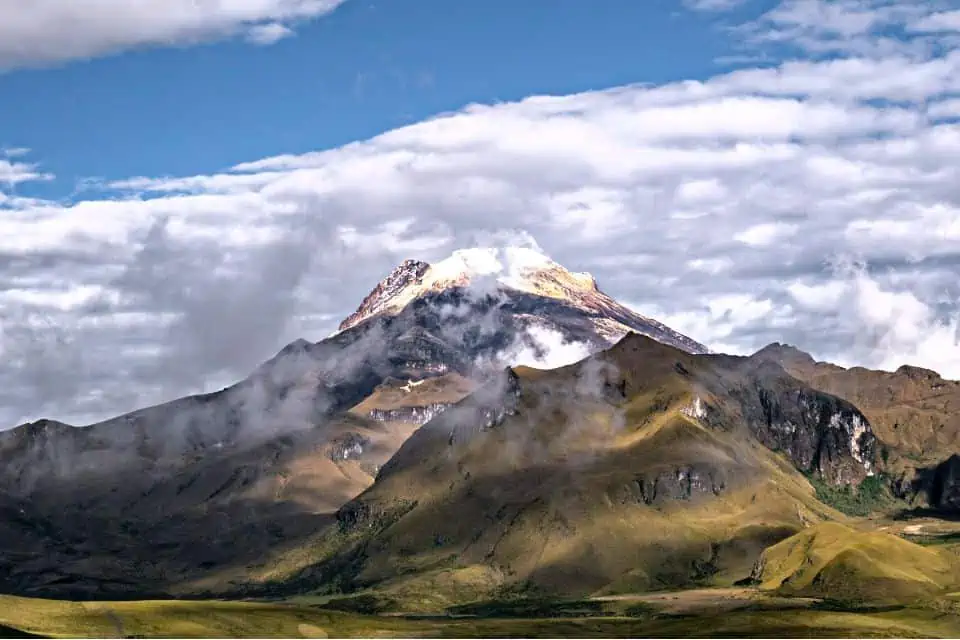
Situated in the heart of the Andes Mountains, Los Nevados National Natural Park is home to some of Colombia’s most stunning glaciers. The park is also home to a number of endangered species, including the Andean condor and the spectacled bear.
Los Nevados National Natural Park covers an area of over 58,000 hectares and is one of the largest protected areas in Colombia. One of the park’s most famous highest peaks is Nevado del Ruiz, which stands at an impressive 5,321 meters above sea level. It is the only high peak in the park accessible by car.
The park’s glaciers are retreating at an alarming rate, due to climate change. As a result, the park has become a popular destination for hikers and nature lovers alike.
21. La Candelaria, Bogota’s Historic Center
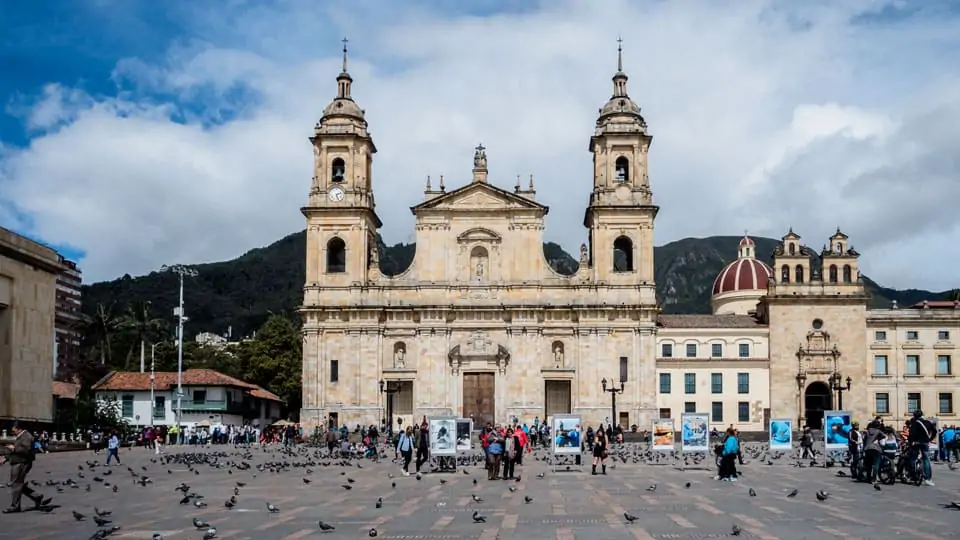
The historical center of Bogotá, La Candelaria is a must-visit for any traveler to the Colombian capital. The neighborhood is home to a number of important landmarks, including the Plaza de Bolívar and the Palacio de Nariño.
La Candelaria is also home to a number of museums, including the Museo del Oro, which houses the largest collection of pre-Columbian gold in the world. The Botero Museum showcases some of the most important artworks of Latin America, as well as works of the famous Colombian artist and sculptor, Fernando Botero.
The neighborhood is also home to a number of colonial-era buildings, many of which have been converted into hotels and restaurants. Don’t miss out on La Candelaria on your Bogota visit!
Map Of The Best Landmarks In Colombia
Above is a map with all of the landmarks in Colombia we discussed. Using this, hopefully you can plan a Colombia itinerary that allows you to see as many as possible!
Colombian Landmarks FAQs
What are some of the most famous monuments in Colombia?
What are the most famous cities in Colombia?
Before You Go
That concludes our article on the most famous landmarks in Colombia. Now you know which monuments, natural reserves, natural parks, mountains, and cities to visit, we hope you have an amazing trip to Colombia!
Disclaimer: Some of the links above are affiliate links. That means if you book or make a purchase through the links, we will earn a small commission at no extra cost to you! The money will help run this site! Thank you!
